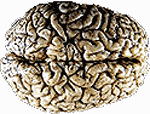| Abracadabra: Bone Marrow Cells Turn into Brain Cells |  |
| Abracadabra: Bone Marrow Cells Turn into Brain Cells |  |
| By Ellen Kuwana Neuroscience for Kids Staff Writer January 23, 2001
Bone marrow, the soft material inside your bones, is composed of at least
two types of In order to trace what happens to the transplanted cells, scientist need a marker, something that identifies the transplanted cells from the cells that were already there. Think of it this way: if you released some ants into an antpile and wanted see where they would go, you would need a way to trace their route. For example, if you put red ants into an antpile that housed black ants, it would be easy to see where your red ants went.
The second team of scientists, led by Eva Mezey of the National Institute of Neurological Disorders and Stroke (NINDS), used a different method to trace the bone marrow cells. They exploited the difference between males and females: males have XY chromosomes and females have XX. The researchers used donor bone marrow cells from adult male mice (XY) and injected the cells into newborn female mice (XX). When examining the brains of the female mice, any cells containing a Y chromosome had to be from the donor cells. Indeed, cells containing Y chromosomes were found in the brain. Although it had been observed before that bone marrow cells could become astrocytes and glial cells ("support"cells in the brain), no one expected a change to nerve cells. |
Much more work needs to be done. The bone marrow cells seem to
have
changed into nerve cells, but are these cells truly nerve cells? They
appear to be making proteins that nerve cells make, but this is not
definite proof that these cells are acting as nerve cells. Here are some
questions that still need answers:
|

|
| One advantage of this approach as a treatment for disease is that
the
cells would come from a patient's own body. In other words, a patient's
bone marrow cells would be used to make his or her brain cells. Thus,
there would be no donor-host incompatibility, such as that sometimes seen
in organ transplants where the host's body rejects the foreign tissue.
This means that there would be no need for immunosuppression, where drugs
are used to quiet the immune system, thus leaving the patient vulnerable
to life-endangering infections. Any step forward in understanding the complicated mechanisms underlying cell differentiation, cell migration, and the various signals that guide these processes is a step towards treatment for diseases characterized by loss of nerve cells. This includes therapies for disorders such as Parkinson's disease, Huntington's disease, and stroke. |
|
References and further information:
|
| BACK TO: | Neuroscience In The News | Table of Contents |
![[email]](./gif/menue.gif) Send E-mail | ![[survey]](./gif/menusur.gif) Fill out survey | ![[newsletter]](./gif/menunew.gif) Get Newsletter | ![[search]](./gif/menusea.gif) Search Pages |